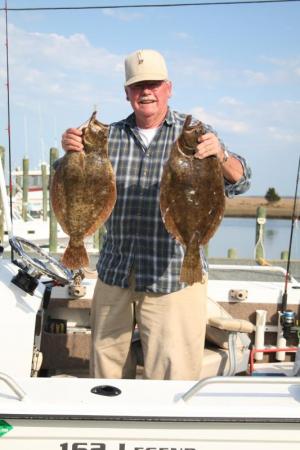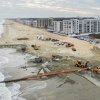No one is more anxious to get out on the water than I am, but right now there is very little action due to the cold water in the ocean and bay. The only location that has seen even a few flounder is the Eastern Shore of Virginia, where the water temperature has flirted with 50 degrees. Three anglers reported catching a limit of flounder out of Folly Creek. The water temperature was 48 degrees when they started and 50 when they quit.
Depending on where you live in Sussex County, the drive time to the Eastern Shore is between an hour to an hour-and-a-half. As a general rule, I fish from Wachapreague or Quinby, but have caught flounder from Chincoteague, Gargatha, Red Bank and all the way down to Oyster.
Some people claim that there is very little water behind the barrier islands of Virginia. Natives claim there is plenty of water there, it is just spread real thin. In either case, it is all but impossible to spend a day fishing there without digging out a new channel. I always plan to arrive right after low tide and fish until just before the bottom of the ebb. I only fish on an east wind to make sure I have maximum water and minimum flesh-eating insects. The only word that describes the insect population behind the barrier islands is intense. Between the flies and mosquitoes, they can suck all the blood from your body quicker than Dracula on a full moon.
I have been fishing there since the early 1970s, but until I met Bob Baker from Seaford, I didn’t know just how many flounder there were. Bob is the best flounder fisherman I have ever met, and he can work the channels and creeks like no one else.
On a normal flounder fishing trip, we will leave Seaford around 6 a.m., and stop for bait at the Sea Hawk Tackle Shop on southbound Route 13 for live minnows, squid and shiners plus some smelt. The next stop will be the Town of Wachapreague’s ramp, where we will launch the boat.
Once we arrive at the first stop, Bob will hand me a small cooler with live minnows, squid strips, shiners and a few smelt so I am not going to bother him asking for bait all day long. Bob makes his own flounder rigs, and he will hand me two rods already rigged with his creations. His boat was rigged for two anglers. I get to sit on the bow, while he sits at the helm. He never turns off the motor and is constantly kicking it in and out of gear to keep the boat tracking exactly where he wants.
If the first location proves unsuccessful, we will soon be off to our second. Bob takes into consideration the tide, current, wind direction, water depth, bottom structure and his gut feelings. Once we find some fish, he will keep us on them until they quit biting.
On more than one occasion I have heard Bob complaining about everything possible while both of us are cranking in fish on two rods. He keeps a five-gallon bucket next to each of us where we put flounder until we have time to check the length and put the keepers in the fish box.
Back in the day, Bob had a commercial hook-and-line Virginia fishing license. On more than one occasion we have carried home more than 100 flounder with a minimum size of 15 inches. According to Virginia regulations, commercial fishermen are allowed to keep 14-inch flounder, but Bob never kept anything less than 15 inches.
So what is someone without Bob’s tutelage to do if they want to catch flounder behind the barrier islands? First, get a chart and study it well. Follow the channels until you learn where you can go on what stage of the tide.
Next, ask for help. Sea Hawk Tackle Shop is one place that can give you some idea where the flounder have been caught. There is another tackle shop in the Town of Wachapreague that can help as well. Don’t be ashamed to fish with the fleet. If you find a group of boats all working the same area, chances are good someone has caught a flounder there.
Never go exploring on a falling tide. Wait for incoming water, so when you run aground you won’t have to wait 12 hours to get off.
You will need a Virginia Saltwater Fishing License, available online.
Fishing report
On Wednesday, I decided to drown a few nightcrawlers in the Broadkill River at the Milton Town Dock. The fellow fishing next to me caught a crappie. I caught nothing, again.




















































